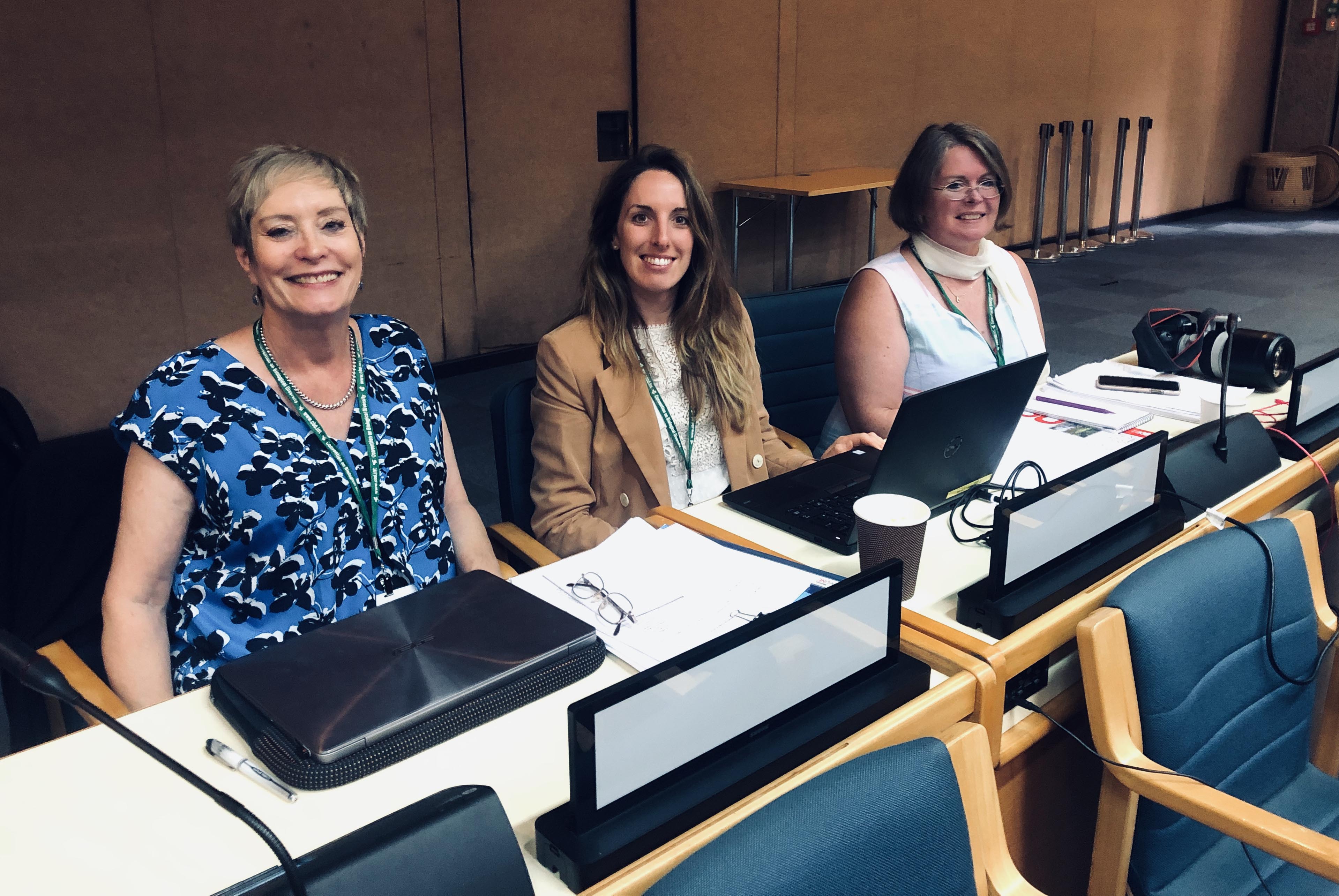Introduction
World Animal Net (WAN)’s Janice Cox has been in Nairobi for the first meeting of the Open Ended Working Group on the Post-2020 Global Biodiversity Framework, which took place from 24-27 August 2019. She was accompanied at the meeting by colleagues from Compassion in World Farming and Born Free Foundation.

The Convention on Biological Diversity
The Convention on Biological Diversity (CBD), which entered into force on 29 December 1993, is dedicated to promoting sustainable development, with three main objectives:
(a) the conservation of biological diversity (all ecosystems, species, and genetic resources);
(b) the sustainable use of the components of biological diversity; and
(c) the fair and equitable sharing of the benefits arising out of the utilisation of genetic resources, notably those destined for commercial use.
Post-2020 Review
The current Strategic Plan of the Convention on Biological Diversity (CBD), which includes the 20 Aichi Biodiversity Targets, is due to expire in 2020. The next meeting of the Conference of the Parties (COP15), which will be held in October 2020 in China, is expected to adopt a new post-2020 global biodiversity framework. This is essentially a global strategic plan to protect biological diversity (animals, plants and ecosystems).
This meeting was the first of three Open Ended Working Groups to develop this new strategic plan. As the first meeting, it concentrated on the process which would be used, and the scope and structure of the new framework.
Future meetings of the working group will be:
2nd working group: 24-28 February 2020, Kunming, China
3rd working group: 27-31 July 2020, Cali, Colombia
There will also be other meetings between these working groups, which are shown on the Annex to the first meeting conclusions. Linked from here.
The IPBES Global Assessment Report on Biodiversity and Ecosystem Services provided the science which was used as a backdrop to the meeting. This provided a bleak assessment of the state of biodiversity – with over one million species at risk of extinction - and a useful analysis of the root causes and drivers of this critical situation.
The rate of global change in nature during the past 50 years is unprecedented in human history. The direct drivers of change in nature with the largest global impact have been (starting with those with most impact):
- Changes in land and sea use;
- Direct exploitation of organisms;
- Climate change;
- Pollution; and
- Invasion of alien species.
Those five direct drivers result from an array of underlying causes – the indirect drivers of change – which are in turn underpinned by societal values and behaviours that include production and consumption patterns and human population.
Agricultural expansion is the most widespread form of land-use change, with over one third of the terrestrial land surface being used for livestock and crops (including crops used to feed livestock).
Human activities have also had a large and widespread impact on the world’s oceans. These include direct exploitation, in particular overexploitation, of fish, shellfish and other organisms, land- and sea-based pollution, including from river networks, and land/sea-use change, including coastal development for infrastructure and aquaculture.
Civil Society Advocacy
WAN is part of larger civil society alliance working to positively influence the CBD - the CBD Alliance. The CBD Alliance held daily coordination meetings, organised meetings with regional groupings, prepared a daily newsletter for delegates (ECO) and coordinated civil society statements. WAN was able to take part in the drafting of these statements, and published an article in the first edition of ECO, which we were pleased to see on the front page! This was entitled “Essential ingredients for a successful Post-2020 Global Biodiversity Framework: Political will and addressing drivers of biodiversity loss”, and addressed key animal protection concerns and call for “bold measures proportionate to the catastrophic losses our planet is experiencing” and “a new ethic, where nature and animals are respected and protected by humankind”.
Copies of civil society statements and other ECO newsletters are available here.
WAN also worked with Compassion in World Farming and Born Free Foundation to draft a statement calling for the recognition of the importance of individual animals and their health and welfare, as sentient beings. See this statement here.
WAN also cooperated with the Women’s Caucus, championing gender issues and supporting the drafting of their statements.
Animal Protection Interests
The Convention on Biological Diversity has been prepared from a conservation perspective, and animal protection organisations have only recently engaged to encourage a more animal welfare-friendly approach. Its current scope and content focusses on the sustainability of ecosystems and species, rather than individual animal interests, and on “sustainable use” and benefit sharing from such use.
However, a number of the existing Aichi Targets would be supportive animal protection interests, if effectively implemented – particularly in terms of the protection of wildlife and habitats, and the move from destructive industrial animal agriculture systems towards sustainable farming practices.
Aichi Targets Relevant to Animal Protection Issues
 Target 3
Target 3
By 2020, at the latest, incentives, including subsidies, harmful to biodiversity are eliminated, phased out or reformed in order to minimize or avoid negative impacts, and positive incentives for the conservation and sustainable use of biodiversity are developed and applied, consistent and in harmony with the Convention and other relevant international obligations, taking into account national socio economic conditions.
 Target 4
Target 4
By 2020, at the latest, Governments, business and stakeholders at all levels have taken steps to achieve or have implemented plans for sustainable production and consumption and have kept the impacts of use of natural resources well within safe ecological limits.
 Target 5
Target 5
By 2020, the rate of loss of all natural habitats, including forests, is at least halved and where feasible brought close to zero, and degradation and fragmentation is significantly reduced.
 Target 6
Target 6
By 2020 all fish and invertebrate stocks and aquatic plants are managed and harvested sustainably, legally and applying ecosystem based approaches, so that overfishing is avoided, recovery plans and measures are in place for all depleted species, fisheries have no significant adverse impacts on threatened species and vulnerable ecosystems and the impacts of fisheries on stocks, species and ecosystems are within safe ecological limits.
 Target 7
Target 7
By 2020 areas under agriculture, aquaculture and forestry are managed sustainably, ensuring conservation of biodiversity.
 Target 8
Target 8
By 2020, pollution, including from excess nutrients, has been brought to levels that are not detrimental to ecosystem function and biodiversity.
 Target 10
Target 10
By 2015, the multiple anthropogenic pressures on coral reefs, and other vulnerable ecosystems impacted by climate change or ocean acidification are minimized, so as to maintain their integrity and functioning.
 Target 11
Target 11
By 2020, at least 17 per cent of terrestrial and inland water, and 10 per cent of coastal and marine areas, especially areas of particular importance for biodiversity and ecosystem services, are conserved through effectively and equitably managed, ecologically representative and well connected systems of protected areas and other effective area-based conservation measures, and integrated into the wider landscapes and seascapes.
 Target 12
Target 12
By 2020 the extinction of known threatened species has been prevented and their conservation status, particularly of those most in decline, has been improved and sustained.
 Target 13
Target 13
By 2020, the genetic diversity of cultivated plants and farmed and domesticated animals and of wild relatives, including other socio-economically as well as culturally valuable species, is maintained, and strategies have been developed and implemented for minimizing genetic erosion and safeguarding their genetic diversity.
Furthermore, the current review provides an opportunity for the addition of more targets and indicators relevant to animal protection interests – particularly those addressing the “root causes and drivers” of biodiversity loss.
Connections to Other Animal Protection Advocacy Streams
The review of the post-2020 framework for biological diversity has links to some other strands of animal protection advocacy, including:
CITES
The new CITES strategic plan includes its contribution to the Sustainable Development Goals and the post-2020 framework. Clearly, their successes will be in vain, if other threats to biodiversity continue.
FAO
FAO was keen to ensure that the paper makes mention of many links between agriculture and biodiversity, including biodiversity-based approaches, a food systems perspective and sustainable production and consumption.
FAO is the custodian of 21 SDG indicators, and is seeking close alignment.
There is also a FAO strategy on mainstreaming biodiversity.
World Bank
The World Bank stressed the importance of mainstreaming biodiversity.
It called for the inclusion of agriculture, aquaculture and forestry, and targets that address the drivers (both direct and indirect) of biodiversity loss, and the removal of perverse incentives and the addition of positive incentives.
The Bank has a work agenda to measure economic impacts of biodiversity.
UNEP
UNEP is actively involved in the CBD process, and wants to strengthen their role in the post-2020 framework. They view the body of Multilateral Environmental Agreements (MEAs) as collectively providing the global framework for curbing biodiversity loss, and stressed the need for increased cooperation and collaboration between conventions.
Outcomes
The official reports on the outcomes of the meeting can be downloaded here. These include these key documents, under the section on “Plenary”:
- Report of Meeting
- Annex to Report (which includes a wide range of contributory meetings)
- Possible elements of a post-2020 global biodiversity framework (a “Non-Paper”, for further discussion)
There is also information on the IISD website – see here. This includes an overview and daily highlights (including many photos).
Particularly encouraging was recognition of the need for transformative change, the inclusion of root causes and drivers (direct and indirect), and a new focus on implementation. We will need to ensure that these aspects stay embedded in future negotiations.
There are plans to hold thematic working groups on the main root causes and drivers (as above under Underlying Science), which will be of interest to animal protection organisations.
This process holds considerable scope for furthering animal protection interests, particularly through these root causes and drivers, and WAN recommends that the animal protection community dedicates itself to the research and preparation needed to make an effective contribution.

